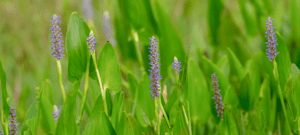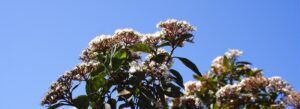There are two ways of thinking when it comes to preparing your native perennial garden beds for winter: tidy things up or do nothing at all. Cleaning up gardens and landscaping in the fall by removing dead plant leaves, stems, and seed heads is the conventional practice. Recently, more nature-minded gardeners have left their gardens as is to help wildlife through the winter.
For the new Garden Refresh native plant beds at McDonald Farm, we won’t have much to do to prepare the garden for winter since the plants are small this first year. However, we will leave stems standing and collect seeds from dried out flowers. There are still a few more spaces to fill but, the plants we want are not currently available. We look forward to getting the rest of the plants in the ground in the spring!
If you have a more established native garden, below are different methods for preparing your garden for winter:
Native But Neat: Full Garden Clean-Up
If you want a tidy landscape in the winter, the conventional garden clean-up is the way to go. This means cutting back and removing dead plant material in late October or November. Shrubs shouldn’t be pruned in the fall. Instead, prune in late winter or early spring to stimulate new growth.
Even if you don’t plan a full fall clean-up, it is wise to remove seed heads of plants you want to contain. Deadheading is important for “enthusiastic” self-seeding plants, such as purple coneflower, joe-pye weed, and flowers in the Aster family in general.
Benefit Wildlife Year-Round: Leave It Be
The other end of the spectrum—leaving all plant material in your garden over the winter—is becoming more popular. Native flowers, grass, shrubs and trees help wildlife year-round. If you delay cutting back your plants until the spring, you’ll support the environment in a few ways:
Places to Hibernate
Native plants provide beneficial insects with a place to overwinter. Some, such as mason bees, nest in hollow stems of native plants. Others, like Luna moths, hibernate under leaf litter. If we remove all plant material from our gardens, we remove crucial habitat for many native insects.
Nourishment for Birds
Birds that do not migrate for the winter need to food to survive the tough climate. Native flower seed heads persist through the winter and are an important food source for birds.
Protection for Plants
Dead plant material and snow that layers on top of it insulates and protects plant roots from freezing temperatures.
Nutrients for Soil
If leaves are left to decompose in garden beds, they will add nutrients to the soil. For quicker decomposition, you can mulch leaves first with a lawnmower and add them back to the garden.
“Winter interest” is another perk of leaving plants over the winter. Stalks, seed heads, and grasses can look lovely under a light layer of snow and add interest to your snow-covered landscape.


The Middle Path: Pick and Choose
Of course, what you plan to do in your garden might fall somewhere between cleaning it all up and leaving it be. A good in-between might be to clean up messy stems but keep seed heads and fallen leaves. This way, you can clean up more wild-looking parts of your landscaping and still keep some organic matter for winter wildlife.
Another strategy is to cut back the earlier blooming perennials while leaving later blooming perennials. Since it’s best to clean out the dead material eventually, cutting back the early bloomers will save some time prepping your garden in the spring.
Outside of the garden, other good fall habits include cleaning and organizing garden tools, draining and storing hoses, and cleaning gutters.


Old plants can still add dimension and interest to your gardens in the winter!
Native Plants for a Healthy Local Ecosystem
Regardless of your landscaping style, we want native plants in our neighborhoods to help wildlife and infiltrate stormwater into the soil. Especially since some homeowner’s associations require a traditional landscaping look, maintaining a “native but neat” garden is the best option for many people in more developed, suburban areas. These native flowers, grasses, and shrubs still help the ecosystem in the livelier part of the year.
If you have control over your landscaping and don’t mind a more natural look, consider leaving your garden as is to provide cover and food for birds and insects in the winter.




